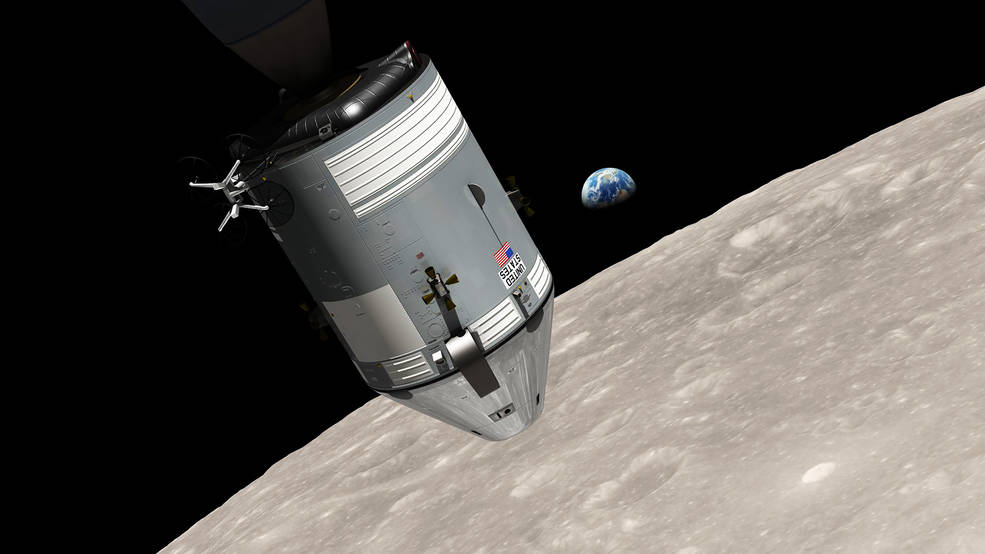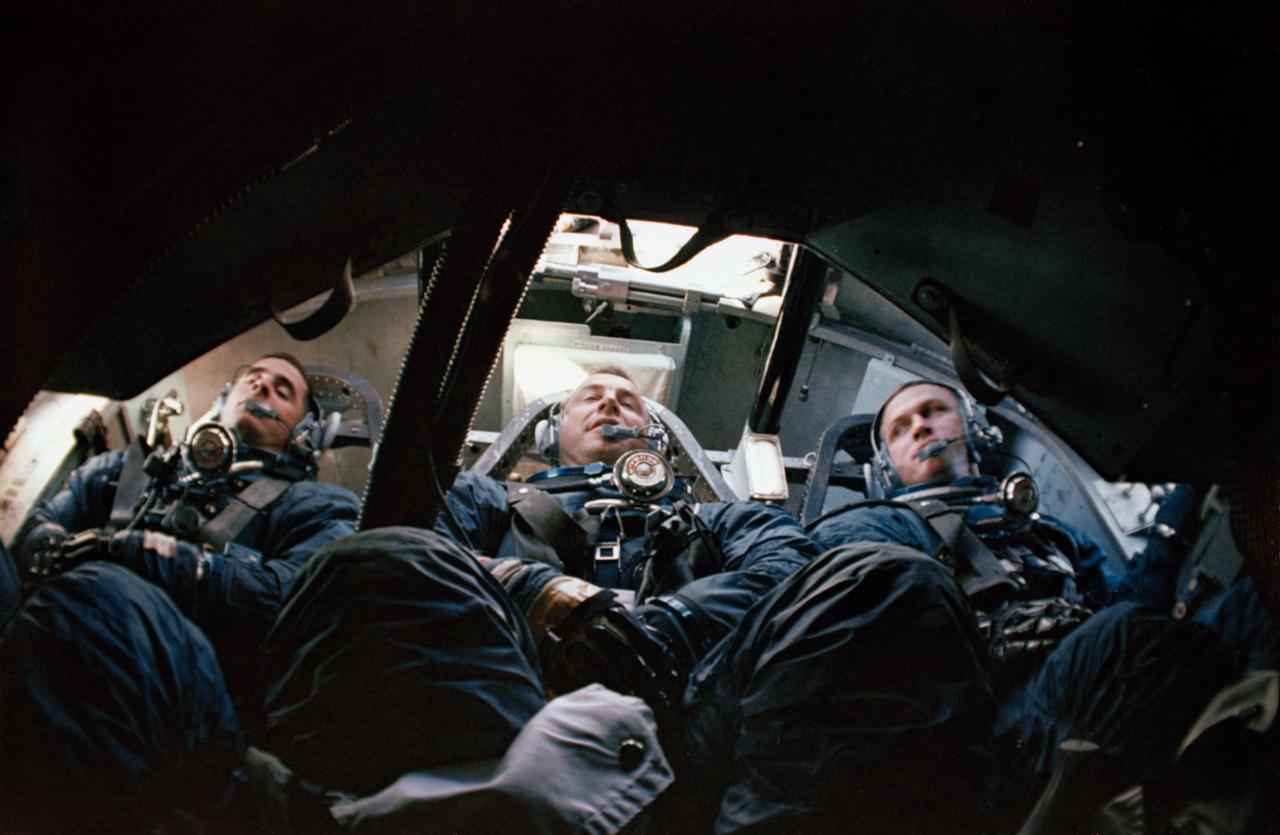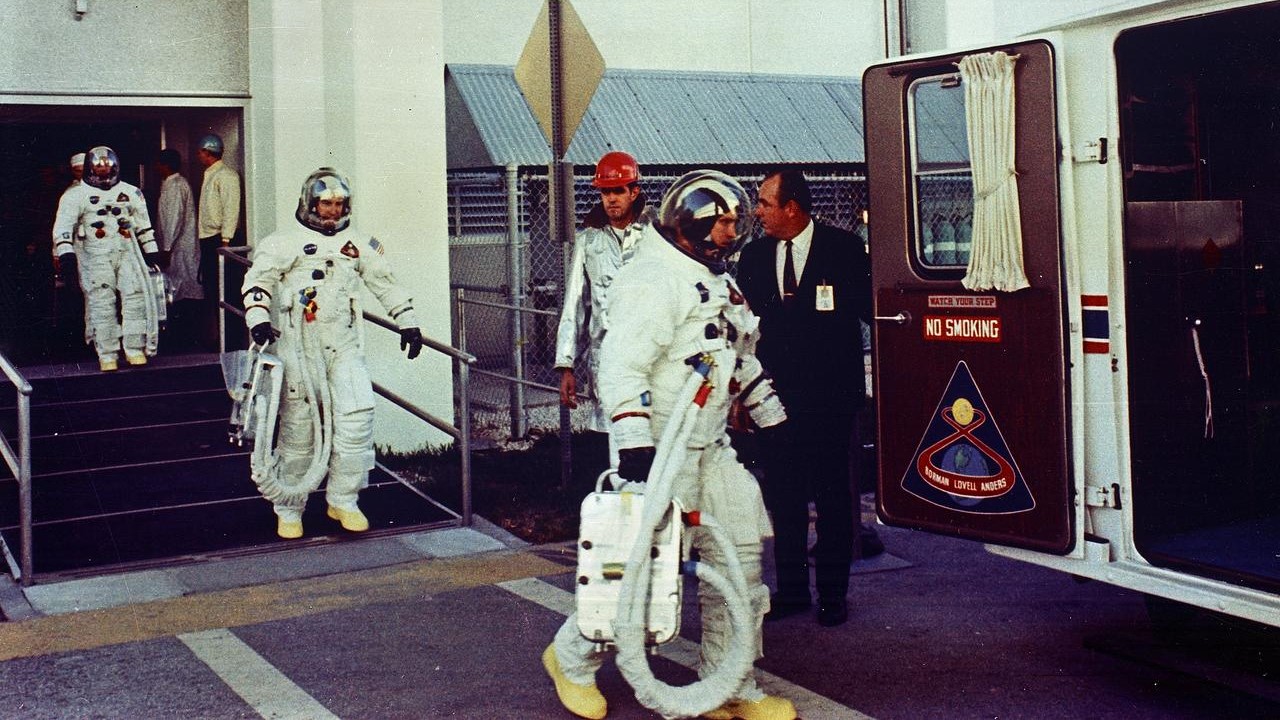Apollo 8: Everything you need to know
NASA's Apollo 8 mission, launched in 1968, represented a vital milestone in human space exploration: carrying the first crew to beyond low Earth orbit and toward the moon.

In 1968, NASA's Apollo 8 mission changed the course of crewed space exploration forever. Apollo 8 represented the first time a space agency had sent humans beyond low Earth orbit and to an orbit around the moon.
Apollo 8 blasted off atop a Saturn V rocket from launchpad 39A at Kennedy Space Center on Dec. 21, 1968, carrying astronauts Frank Borman, James Lovell Jr. and William Anders into a 114-by-118-mile (183 by 190 kilometers) parking orbit at 32.6 degrees, according to NASA. On Christmas Eve of the same year, Apollo 8 completed 10 orbits of the moon in 20 hours before heading back to Earth. It landed safely in the Pacific Ocean on Dec. 27.
In addition to achieving this milestone and setting the stage for the Apollo 11 moon landing the following year, Apollo 8 is known for another accomplishment: capturing an image of Earth that would redefine the way we see our planet and our place in the universe forever.
Apollo 8 FAQs
What happened with Apollo 8?
The Apollo 8 spacecraft launched on Dec. 21, 1968. It orbited the moon 10 times and then landed in the Pacific Ocean on Dec. 27, 1968. During its flight, which was the first time humans left Earth orbit and orbited the moon, astronaut Bill Anders captured the famous "Earthrise" image, the first color image of Earth taken from space, which would spur the creation of Earth Day in 1970 and inspire a burgeoning environmental movement.
Why didn't Apollo 8 land on the moon?
Apollo 8 was never designed to land on the moon; the spacecraft lacked a lunar lander and the retro boosters needed for a lunar landing. It was, however, originally intended to be the first Earth-orbital test of NASA's lunar landing module, according to the Lunar Planetary Institute. However, NASA was behind schedule with the lander, so instead, the agency decided to send Apollo 8 to a lunar orbit.
Who were the three astronauts on Apollo 8?
The three astronauts on Apollo 8 were Mission Commander Frank Borman, Lunar Module Pilot William Anders and Command Module Pilot James Lovell.
Planning the Apollo 8 mission
Apollo 8 was the second crewed flight of the Apollo program and the first crewed flight of the Saturn V launch system, which was, at the time, the most powerful rocket ever created.
NASA describes the mission objectives as a coordinated performance of the crew, the command and service module (CSM), and the test support facilities, like communications, navigation and tracking. Additionally, Apollo 8 would aim to demonstrate translunar injection and refine systems and procedures required for future lunar operations, including the Apollo 11 moon landing in 1969. All of these objectives were achieved, with NASA reporting that the Apollo 8 vehicle and its support infrastructure had performed as expected.
The mission could have been quite different, however. According to the Lunar Planetary Institute (LPI), Apollo 8 was initially intended to be a test of NASA's Lunar Module in orbit around Earth. However, this couldn't happen because the completion of the Lunar Module was running behind schedule.
Rather than postponing the mission, NASA wanted to maintain its launch schedule and instead decided that Apollo 8 would journey to the moon. The crew began training for a lunar journey, but according to the LPI, it wasn't until Nov. 12, 1968 — just six weeks before launch — that NASA finally decided that Apollo 8 would make an audacious jaunt to the moon.
Breaking space news, the latest updates on rocket launches, skywatching events and more!
Meet the crew of Apollo 8
Borman commanded the Apollo 8 mission. Born on March 14, 1928, in Gary, Indiana, he graduated from the U.S. Military Academy West Point in 1950. He then joined the U.S. Air Force and flew with the 44th Fighter Bomber Squadron in the Philippines between 1951 and 1956.
In 1962, Borman was selected to join NASA as a member of its second group of astronauts. Apollo 8 wasn't his first space mission, however; he flew on the seven-day Gemini 7 in 1965 with Lovell, who commanded Gemini 7 and would serve as command module pilot for Apollo 8.
Lovell was born on March 25, 1928, in Cleveland. He became a test pilot after graduating from the U.S. Naval Academy in Annapolis, Maryland, in 1952. In 1963, he joined NASA and, two years later, accompanied Borman on Gemini 7.
Following Apollo 8, when he became the first commander of a prior mission to serve as a crewmate on another mission, Lovell would be part of the nearly disastrous Apollo 13 mission. Apollo 13 launched on April 11, 1970, heading to the moon with Lovell, Fred Haise, and John "Jack" Swigert Jr. aboard. Two days into the flight, an oxygen tank ruptured and caused a power outage and oxygen shortage. Apollo 13 swung around the moon and returned safely to Earth on April 17. Lovell stayed with NASA after the Apollo 13 crisis, becoming deputy director of Johnson Space Center in Houston in 1971.
Apollo 8 would be the only spaceflight undertaken by Anders, the youngest member of the crew, who was born on Oct. 17, 1933, in Hong Kong. In 1955, Anders graduated from the U.S. Naval Academy in Annapolis, Maryland. He joined the U.S. Air Force and obtained a master's degree in nuclear engineering in 1962. In 1963, he was selected for NASA, and five years later, he served as Lunar Module pilot for the Apollo 8 mission, though Apollo 8 didn't actually carry a lunar module but rather a Lunar Test Article of the same weight.
Orbiting the moon in Apollo 8
The Saturn V rocket carrying Apollo 8 launched at 7:51 a.m. EST (1251 GMT) on Dec. 21, 1968. During the launch, Lovell reported that the noise in the Apollo 8 Command Module was so great that communication with ground control was effectively cut off, according to The Planetary Society.
But the flight was a success: Apollo 8 reached Earth orbit after just 12 minutes and orbited the planet twice. Then Apollo 8 fired its third-stage engines, which injected it into the translunar trajectory needed to send a spacecraft to the moon.
Apollo 8 reached orbit around the moon on Dec. 24, 1968, at 4:59 a.m. EST (0959 GMT), settling into an orbit around 70 miles (113 km) from the lunar surface. It spent 20 hours around the moon, during which the spacecraft and its crew completed 10 orbits. During this time, Apollo 8, with optimal lighting, surveyed the prime potential landing site for Apollo 11, according to the LPI. The mission also took geological observations of other lunar features and imaged the moon's surface.
Ground control lost contact with Apollo 8 when the spacecraft passed around to the "dark" side of the moon. This side of the moon isn't actually dark, however, as it does receive illumination from the sun. It's often labeled "the dark side" because it is never seen from Earth, as the moon is tidally locked to our planet and thus shows us only one side. As such, the Apollo 8 crew became the first humans to see the far side of the moon.
At 1 a.m. EST (0610 GMT) on Dec. 25, Apollo 8 fired its engines again and moved to the trans-Earth injection orbit needed to bring the crew back home. On Christmas morning, as ground control anxiously awaited radio contact from Apollo 8, Lovell radioed through, saying, "Roger, please be informed there is a Santa Claus," according to NASA.
After 147 hours in space, Apollo 8 splashed down in the Pacific Ocean around 1,000 miles (1,600 km) off the coast of Hawaii. The spacecraft and its crew were recovered by the USS Yorktown. The Apollo 8 Command Module currently resides at the Museum of Science and Industry in Chicago.
Earthrise and the Christmas Eve broadcast
While Apollo 8 was in orbit around Earth on Dec. 24, 1968, Anders used color film on the spacecraft crew's Hasselblad cameras to capture an image of Earth as it rose behind the moon. Officially known as "NASA image 2383" but more commonly called "Earthrise," the photo would become one of the most famous pictures in history.
According to the BBC, as Anders took the photo, he said to Lovell, "Oh my God, look at that picture over there! There's the Earth coming up. Wow, is that pretty! … You got a color film, Jim? Hand me a roll of color, quick, would you?"
Though seemingly an innocuous remark, the request for color film would make history, with Earthrise becoming the first color image of Earth taken from space. The image became so powerful — demonstrating Earth's fragility and humanity's place in a vast universe — that it inspired a growing global environmental movement. Earthrise is also credited with inspiring the 1970 creation of Earth Day, which is now held annually on April 22.
Earthrise wasn't the only Christmas gift that Apollo 8 delivered to Earth. Also on Dec. 24, 1968, the mission's astronauts delivered a message from space to the people of Earth. The crew read passages from the Book of Genesis as an audience, estimated to be around one-quarter of the world's population at the time — around a billion people across 64 countries — watched and listened.
"We are now approaching lunar sunrise, and for all the people back on Earth, the crew of Apollo 8 has a message that we would like to send to you," Anders said" before reading the first passages from Genesis.
Borman concluded the broadcast with the final passages and these words: "And from the crew of Apollo 8, we close with good night, good luck, a Merry Christmas — and God bless all of you, all of you on the good Earth."
Apollo 8 in the media
The Apollo 8 crew's reading of Genesis has found its way into a multitude of music tracks. Anders' words were sampled on the first two tracks of Mike Oldfield's 1994 album "The Songs of a Distant Earth," titled "In the Beginning" and "Let There Be Light."
Michael Jackson used the end section of the Genesis reading on his 1995 album "HIStory: Past, Present, and Future, Book I" in 1995. Sections of the broadcast were also used by Christian rock band Brave Saint Saturn in 2000 and prog-rock band Arena in 2005. Swedish prog-rock band Moon Safari used the first two sentences of Bill Anders' part on their song "Moonwalk". and DJs Bakermat and W&W used exerts in their songs in 2013.
The Apollo 8 mission itself has been documented in a wealth of documentaries, including "Debrief: Apollo 8," in 1968, which was hosted by Burgess Meredith, better known for portraying Rocky Balboa's trainer, Mickey Goldmill, in the "Rocky" series. The 50th anniversary of the flight was celebrated in December 2018 by the "Nova" documentary "Apollo's Daring Mission," which aired on PBS.
Also in December 2018, the Paul Hildebrandt-directed documentary "First to the Moon: The Journey of Apollo 8" told the story of Apollo 8 and featured interviews with Anders, Borman and Lovell.
On the big screen, Lovell was portrayed by Tom Hanks in Ron Howard's 1995 movie "Apollo 13," which tells the story of that harrowing NASA mission. One of Lovell's primary motivations in the film is that he orbited the moon as part of Apollo 8 but was denied the chance to step foot on the lunar surface.
Apollo 8 expert Q&A
We asked NASA Chief Historian Brian C. Odom for his insight into the Apollo 8 mission and its importance.
What was special about the Apollo 8 mission? What were the main aims of the mission?
Apollo 8 was the first crewed spacecraft to successfully orbit the moon. The mission was critical to proving that the Saturn V launch vehicle and life support systems could send humans to the moon and return them safely to Earth.
Why didn't Apollo 8 land on the moon?
As the objects were to test out the ability to get a crew to and from lunar orbit, no lunar module (lander) was included in the mission.
What important things did Apollo 8 teach NASA for future Apollo missions?
Apollo 8 taught NASA that the integrated system of the Saturn V launch vehicle and the Apollo spacecraft could send humans to the moon and verified that the life support systems would safely sustain the three-person crew for the duration of the mission.
What do you think is the most fascinating aspect of the Apollo 8 mission?
I think that, beyond proving the ability to accomplish President Kennedy's important overall goal, the most fascinating thing about the Apollo 8 mission was the unscheduled "Earthrise" event captured on camera from lunar orbit. This image galvanized a fledgling environmental movement and forever changed humanity's perspective of Earth. The Apollo 8 mission came at the end of a tragic year in which Dr. Martin Luther King Jr. and Robert Kennedy had both been assassinated. Apollo 8 and the "Earthrise" photo offered a bit of optimism in a very bleak moment in history.
Additional resources
Watch NASA Chief Scientist and Senior Climate Advisor Kate Calvin speak to Apollo 8 astronaut Bill Anders about the "Earthrise" image and how it inspired Earth Day. Learn more about the story of the space race between the U.S. and the Soviet Union and how it led to the Apollo missions in this NASA video. See footage of the Apollo 8 mission launch atop the incredibly powerful Saturn V rocket.
Bibliography
Apollo 8, NASA, [Accessed 08/15/23], [https://www.nasa.gov/mission_pages/apollo/apollo-8.html]
Apollo 8 Astronaut Bill Anders Captures Earthrise, NASA, [Accessed 08/15/23], [https://www.nasa.gov/image-feature/apollo-8-astronaut-bill-anders-captures-earthrise]
Apollo 8, NASA, [Accessed 08/15/23], [https://www.nasa.gov/mission_pages/apollo/missions/apollo8.html]
Apollo 8, the Planetary Society, [Accessed 08/15/23], [https://www.planetary.org/space-missions/apollo-8]
Apollo 8 Mission Overview, LPI Resources, [Accessed 08/15/23], [https://www.lpi.usra.edu/lunar/missions/apollo/apollo_8/]

Robert Lea is a science journalist in the U.K. whose articles have been published in Physics World, New Scientist, Astronomy Magazine, All About Space, Newsweek and ZME Science. He also writes about science communication for Elsevier and the European Journal of Physics. Rob holds a bachelor of science degree in physics and astronomy from the U.K.’s Open University. Follow him on Twitter @sciencef1rst.





